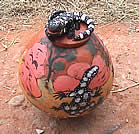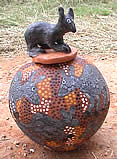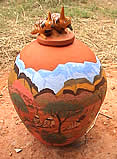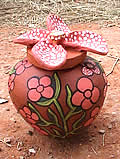Hermannsburg pottery is now a famous feature of this community
of 800 Western Arrernte people, located 130 kilometres west
of Alice Springs. Pottery was first introduced to the Aboriginal
artists of Hermannsburg in the 1960s by missionaries working
with men from the community. These men, and subsequently both
men and women artists, built on the tradition
of Aranda (also called Arrernte) art that can
be traced back to Albert Namatjira.
Today, with continued help from their pottery trainer (a
practising ceramicist and teacher) and the traditional owners
of the region, a small group of mostly women produces unique
and highly saleable works of ceramic art.
These women (and the newer artists that have followed) use
the introduced medium of clay to translate their cultural
and artistic heritage. In a small pottery studio in the centre
of the community the Hermannsburg Potters have forged their
own unique type of ceramics.
Their distinctive style features small figures of birds,
animals, lizards or plants which are sculpted onto the lid
as well as painted onto the body of the pot. The potters do
not limit themselves to the use of traditional images alone,
and often incorporate fish, dragons, sharks and animals such
as goats and zebras into their work.
Frequently now the potters are engaged in the production
of large relief clay tiles for murals. Their depictions of
bush food and Dreaming stories can be seen on murals at the
interpretive displays and in the visitors areas in national
parks and tourist destinations around Alice Springs. Their
murals can also be seen at Taronga Zoo in Sydney and the Beverley
Hills Library in California, USA. More recently the artists
have been producing paintings on canvas.

Carol Rontji
Iyah (emu) |

Lindy Panangka Rontji
Alakuki (Galahs) |
 Lindy Panangka Rontji
Lindy Panangka Rontji
Ramiya (Lizard)
|
 Irene Mbitjana Entata
Irene Mbitjana Entata
Turkia (Field Mouse) |
 Irene Mbitjana Entata
Irene Mbitjana Entata
Nturute (Rock Pigeons)
|
 Rona Rubuntja
Rona Rubuntja
Nteta (Wild Flowers) |